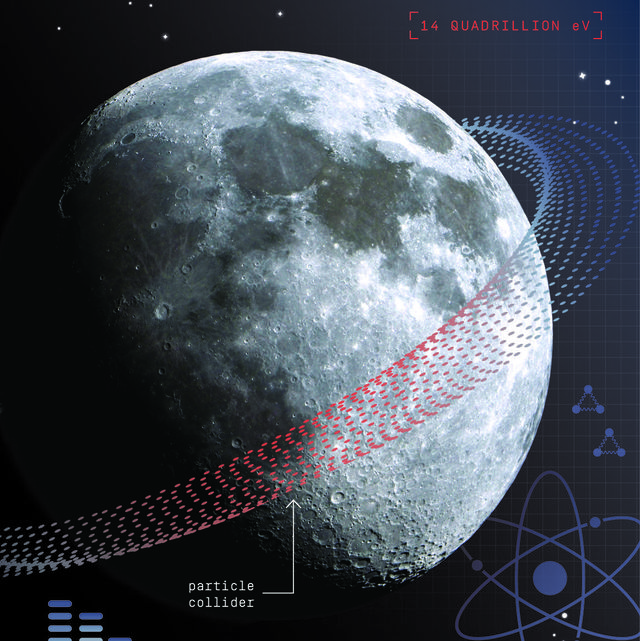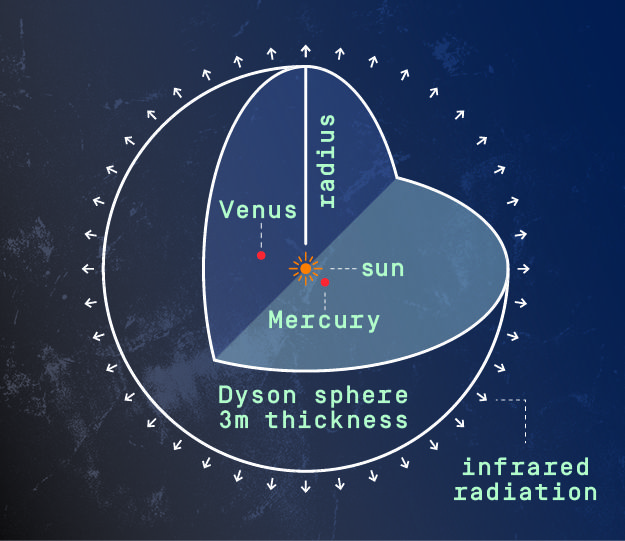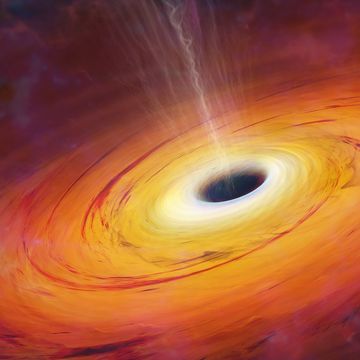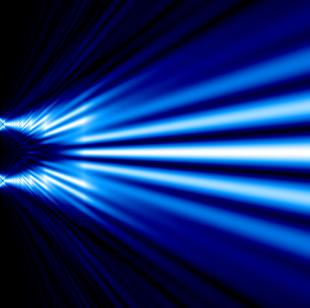Cast your mind forward 150 years and picture a truly wild piece of infrastructure: a particle collider that circles the entire moon like a belt. It might sound outlandish, but the physicists who proposed this idea in 2021 say that the vast structure could be possible in the next century.
Particle colliders propel charged particles like protons and electrons together at high speeds. On Earth, some are circular, like the Large Hadron Collider (LHC) in Geneva, Switzerland. Others are built in straight lines. Both designs help particles reach phenomenal speeds.
The energy from the collisions can create matter in the form of new particles, including some of the largest ones that we know of (like the Higgs boson, a fundamental particle that helps give other particles mass). So having the extra space to build a bigger, more powerful particle collider could potentially lead scientists to the discovery of other new particles. These particles help to glue together disparate physics ideas and move us toward a more complete understanding of the universe. A megastructure on the moon, for its part, could enable particle acceleration that reaches 14 quadrillion electron volts, or about 1,000 times more energy than the LHC—the most powerful particle collider on Earth.
“We have big open questions in science and particle physics and we don’t have any more theoretical hints as to where we should go to solve them,” says James Beacham, Ph.D., a particle physicist working for Duke University, who helped theorize the lunar collider. By building an enormous collider, we increase the likelihood of discovering the next Higgs boson. We can also continue to study the birth of the universe by “rewinding” another hair’s breadth toward the Big Bang.
Building this kind of massive infrastructure on the moon may seem like an insurmountable challenge. But, Beacham says, the steps to do so are both practical and possible.
Step No. 1: Send the workforce to the moon for surveys
First, scientists will need to see what materials are available on the moon—and what they’ll need to bring from Earth. The collider could use regular, supercooled magnets or “higher-temperature” (approximately 100° Kelvin or –173° Celsius) magnets, so researchers need to determine whether or not there are enough naturally occurring materials on the moon to make the higher-temperature magnets. If there are, that could save a lot on transportation costs and infrastructure, because cooling to near 0° kelvin requires so much energy.
Transporting tools and building materials through space is also incredibly expensive. Tunnel-boring machines, alone, can weigh over 1,200 tons (about 240,000 pounds), and NASA estimates that each pound of payload costs $700 to send into Earth’s orbit, let alone the moon’s orbit. (For context, the Apollo program cost an inflation-adjusted $280 billion.)
Step No. 2: Consider how the collider will wrap around the moon
You can take the circumference of a spheroid at any point or location, so the collider doesn’t have to wrap around the widest part of the moon. Scientists say there are great circle routes around the moon that avoid changing elevation, for example.
Step No. 3: Set up manufacturing infrastructure
Initially, mining for materials will be the highest priority. “The best option for a moon-based collider would be to use iron-based, high-temperature superconductors, because it looks like the moon is full of accessible iron,” Beacham says.
Step No. 4: Bore out tunnels for the collider
Beacham says the moon’s surface temperature variations are an immediate problem. An array of superconducting magnets will partly power the particle collider, so the entire structure must be temperature-controlled. “The day-night temp variations on the moon are so large that at least for half of the time, it would be too hot for the magnets to even operate,” Beacham says.
Beacham notes the best bet is to bury the tunnel at least 100 meters underground, where it will still require some cooling, but not nearly as much. At that depth, the collider is also exempt from the moon’s day-night cycle; that helps to maintain its temperature equilibrium.
Step No. 5: Determine a power source
The collider will require so much energy that even all of the existing nuclear fission power on Earth—which supplies about 10 percent of our total energy production—wouldn’t suffice.
It’s estimated that the moon collider will use tens of terawatts of energy, which is closer to what all of humanity uses each day (that number is about 15 terawatts). Here, the scientists suggest using a solar-powered Dyson Sphere, an imagined space “superstructure” that can directly capture energy from a nearby star (see below).
Step No. 6: Build the collider and the infrastructure to “work from home” on the moon
Most people who study the Large Hadron Collider aren’t on site, because they receive huge quantities of data that they can study from anywhere. Beacham believes that the moon collider would be no different. But we do need to figure out the best way to beam large amounts of data from the moon to Earth. More importantly, besides a skeleton crew for maintenance, people on Earth will need to be able to operate the collider. That means something like your remote virtual desktop for your job, except your job is on the moon.
Naturally, there are plenty of roadblocks that could crop up while planning a mega infrastructure project so far into the future. But for now, Beacham is pleased that the collider could at least bring together some of the greatest minds in science. “Let’s harness the power of these people who are really set on going back to the moon, let’s get them to [focus on lunar collider] projects that are for the good of humanity,” he says. “Everybody could win with such a project.”
What Is a Dyson Sphere?
Freeman Dyson, a prolific British- American physicist, first introduced his eponymous Dyson Sphere concept in a landmark 1960 paper. In it, he describes the futuristic energy- capturing structure as a “hollow ball built around the sun.” The theoretical device, covered in solar panels and mirrors, could wrap around a solar system’s largest star to harvest its energy. But because the contraption would cover the sun, it could have dramatic consequences for Earth’s ecosystem.
A better alternative, then, is a Dyson Swarm—a take on the Dyson Sphere that features a collection of smaller, individual harvesters that orbit the sun like satellites, wirelessly transferring solar energy to the moon. —Courtney Linder

Caroline Delbert is a writer, avid reader, and contributing editor at Pop Mech. She's also an enthusiast of just about everything. Her favorite topics include nuclear energy, cosmology, math of everyday things, and the philosophy of it all.














